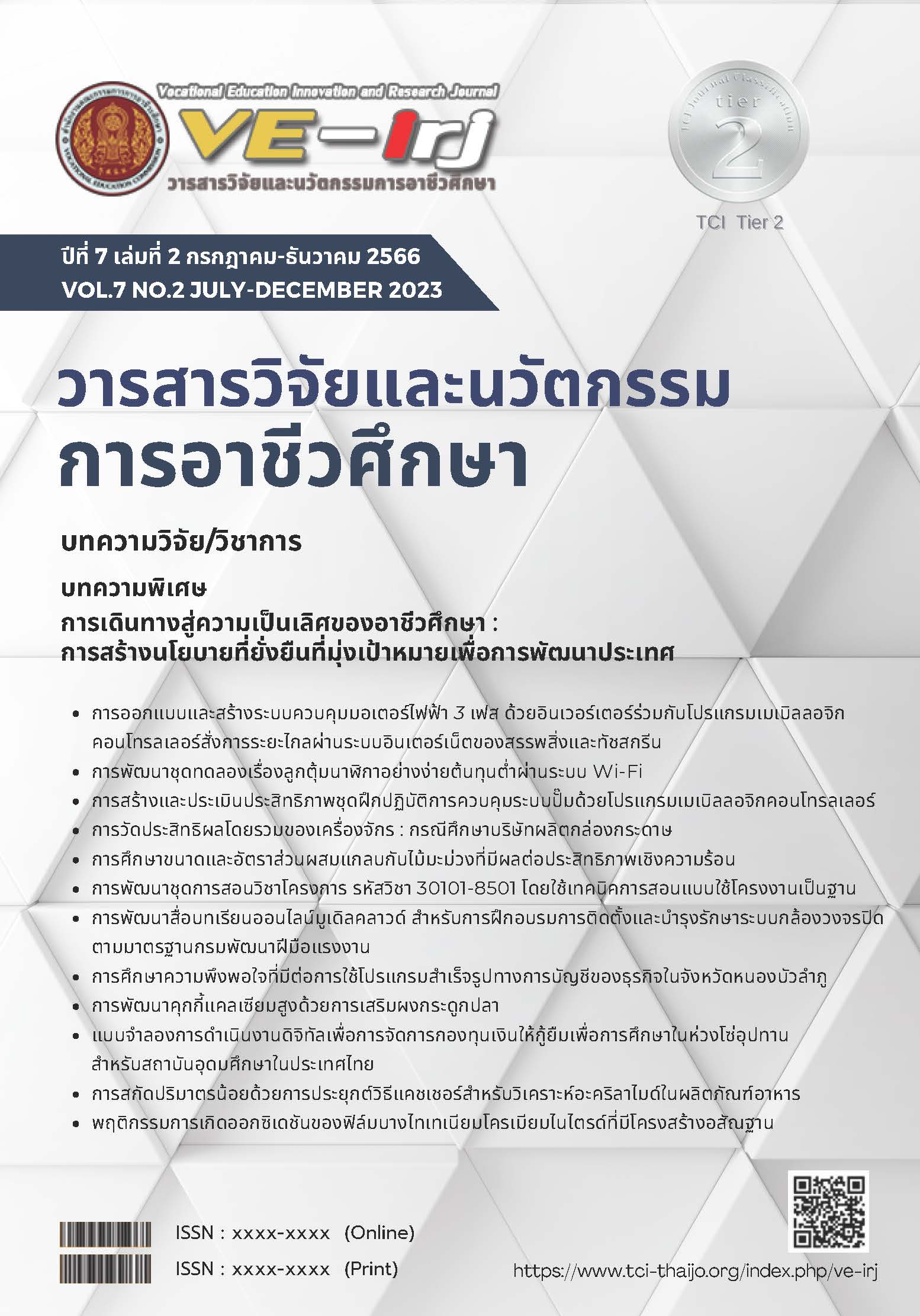พฤติกรรมการเกิดออกซิเดชันของฟิล์มบางไทเทเนียมโครเมียมไนไตรด์ที่มีโครงสร้างอสัณฐาน
Main Article Content
บทคัดย่อ
ฟิล์มบางไทเทเนียมโครเมียมไนไตรด์ (TiCrN) เคลือบบนแผ่นซิลิคอนด้วยเทคนิครีแอคตีฟดีซีแมกนีตรอนสปัตเตอริงจากเป้าสารเคลือบแบบโมเสก พฤติกรรมการเกิดออกซิเดชันของฟิล์มบาง TiCrN ศึกษาโดยอบฟิล์มในบรรยากาศที่อุณหภูมิในช่วง 500-900oC นาน 1 ชั่วโมง นำฟิล์มทั้งหมดไปวิเคราะห์ด้วยเทคนิคการเลี้ยวเบนรังสีเอกซ์ (XRD), เอกซ์เรย์สเปกโทร สโกปีแบบกระจายพลังงาน (EDS) และกล้องจุลทรรศน์อิเล็กตรอนแบบส่องกราดชนิดฟิลด์อีมิสชัน (FE-SEM) สำหรับอัตราการเกิดออกซิเดชันและพลังงานกระตุ้นการเกิดออกซิเดชันคำนวณจากสมการของวากเนอร์และสมการของอาร์เรเนียส ผลการศึกษาพบว่าฟิล์มที่เตรียมได้คือไทเทเนียมโครเมียมไนไตรด์แบบอสัณฐานหลังการอบถึงอุณหภูมิ 900oC พบว่าฟิล์มยังคงมีโครงสร้างผลึกแบบอสัณฐานไม่เปลี่ยนแปลงส่วนผลจาก EDS พบว่าฟิล์มไทเทเนียม, โครเมียม, ไนโตรเจนและออกซิเจนในสัดส่วนต่าง ๆ โดยพบว่าปริมาณออกซิเจนในฟิล์มเพิ่มขึ้นตามอุณหภูมิอบอ่อน ส่วนภาคตัวขวางจากเทคนิค FE-SEM พบว่าที่อุณภูมิ 700oC เริ่มมีชั้นออกไซด์ที่บางมากอยู่บนผิวหน้าของฟิล์ม TiCrN โดยความหนาของชั้นออกไซด์มีค่าเพิ่มขึ้นตามอุณหภูมิ นอกจากนี้ยังพบว่าฟิล์มที่เตรียมได้เกิดเป็นออกไซด์ทั้งหมดที่อุณภูมิ 900oC ผลการศึกษานี้ให้เห็นว่าฟิล์มทนการเกิดออกซิเดชันได้ที่ 600oC โดยอัตราการเกิดออกซิเดชันแปรตามอุณหภูมิอบอ่อน และมีค่าพลังงานกระตุ้นในการเกิดออกซิเดชันของฟิล์มมีค่าเท่ากับ 134.90 kJ/mol
Article Details

อนุญาตภายใต้เงื่อนไข Creative Commons Attribution-NonCommercial-NoDerivatives 4.0 International License.
สงวนสิทธิ์ โดย สถาบันการอาชีวศึกษาภาคตะวันออกเฉียงเหนือ 1
306 หมู่ 5 ถนนมิตรภาพ หนองคาย-อุดรธานี ตำบลโพธิ์ชัย อำเภอเมืองหนองคาย จังหวัดหนองคาย 43000
โทร 0-4241-1445,0-4241-1447
ISSN : 3027-6861 (print) ISSN : 3027-687X (online)
เอกสารอ้างอิง
Witit-anun, N. and Buranawong, A. “Effect of Substrate-target Distance on the Structure of TiCrN Films Deposited from Mosaic Target by Reactive DC Magnetron Sputtering,” Key Engineering Materials. 798: 163-168, 2019.
Krzanowski, J. and Foley, D. “The Effect of Cr Content on the Oxidation Behavior of Ti-Cr-N Films,” Coatings. 4(2): 308-319, 2014.
Danek, M., Fernandes, F., Cavaleiro, A. and Polcar, T. “Influence of Cr Additions on the Structure and Oxidation Resistance of Multilayered TiCrAlN Films,” Surface and Coatings Technology. 313: 158-167, 2017.
Paksunchai, C., Denchitcharoen, S., Chaiyakun, S. and Limsuwan, P. “Growth and Characterization of Nanostructured TiCrN Films Prepared by DC Magnetron Co-Sputtering,” Journal of Nanomaterials, 2014: 1-9, 2014.
Samapisut, S., Tipparach, U., Heness, G. and McCredie, G. “Effect of Magnetron Discharge Power and N2 Flow Rate for Preparation of TiCrN Thin Film,” Procedia Engineering. 32: 1135-1138, 2012.
Golosoc, D.A., Melnikov, S.N. and Dostanko, A.P. “Calculation of the Elemental Composition of Thin Films Deposited by Magnetron Sputtering of Mosaic Targets,” Surface Engineering and Applied Electrochemistry. 48: 52-59, 2012.
Forsén, R., Johansson, M.P., Odén, M. and Ghafoor, N. “Effect of Ti alloying of AlCrN Coatings on Thermal Stability and Oxidation Resistance,” Thin Solid Films. 534: 394-402, 2013.
Witit-anun, N. and Teekhaboot, A., “Effect of Ti Sputtering Current on Structure of TiCrN Thin Films Prepared by Reactive DC Magnetron Co-Sputtering,” Key Engineering Materials. 675-676: 181-184, 2016
Buranawong, A. and Witit-anun, N. “Oxidation Behavior of Nanostructure Sputtered Titanium Nitride Thin Films,” Current Applied Science and Technology, 22(6): 1-11, 2022.
Komatsu, I., Aoki, H., Ebisawa, M., Kuroda, A., Kurroda, K., and Maeda, S. “Color change mechanism of niobium oxide thin film with incidental light angel and applied voltage”. Thin Solid Films, 603: 180-186, 2016.
Aliaj, F., Syla, N., Oettel, H. and Dilo, T. “Thermal Treatment in Air of Direct Current (DC) Magnetron Sputtered TiN Coatings”. Scientific Research and Essays. 11: 230-238, 2016.
Chen, H.Y. and Lu, F.H. “Oxidation Behavior of Chromium Nitride Films”. Thin Solid Films, 515: 2179-2184, 2006.
Youxing, H., Kewei, G., Huisheng, Yang., Xiaolu, P. and Volinsky, A.A. “Nitrogen Effects on Structure, Mechanical and Thermal Fracture Properties of CrN Films”. Ceramics International, 515: 30729-30740, 2021.
Lee, D.B., Kim, M.H., Lee, Y.C., & Kwon, S.C. “High Temperature Oxidation of TiCrN Coatings Deposited on a Steel Substrate by Ion Plating”. Surface and Coatings Technology, 141: 232-239, 2001.
Alaksanasuwan, S., Buranawong, A. & Witit-anun, N. “Structural and Oxidation Behavior of Nanocomposite TiCrN Thin Films”. Suan Sunandha Science and Technology Journal, 9: 53-62, 2022.
Otani, Y. and Hofmann, S. “High Temperature Oxidation Behavior of (Ti1-xCrx)N Coatings”. Thin Solid Films. 287: 188-192, 1996.
Panjan, P., Navinsek, B., Cvelbar, A., Zalar, A. and Milosev, I. “Oxidation of TiN, ZrN, TiZrN, CrN, TiCrN and TiN/CrN Multilayer Hard Coatings Reactively Sputtered at Low Temperature”, Thin Solid Films. 281-282: 298-301, 1996.


